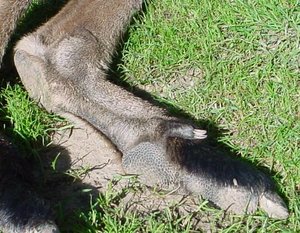Diprotodontia
|
|
| Diprototdonita | ||||||||
|---|---|---|---|---|---|---|---|---|
| Scientific classification | ||||||||
| ||||||||
| Suborders | ||||||||
Diprotodontia is a large taxon of about 120 marsupial mammals including the kangaroos, wallabies, possums, Koala, wombats, and many others. Extinct members include the giant Diprotodon family, and Thylacoleo, the so-called "marsupial lion".
Diprotodonts are almost all herbivorous: there are a few insectivores and omnivores, but these seem to be relatively recent adaptations from the mainstream herbivorous mould.
Diprotodonts are restricted to Australasia. The earliest known fossils date to the late Oligocene. However it is certain that their genesis lies earlier than that: there are large gaps in Australia's fossil record and virtually no record at all in geologically active New Guinea; the great diversity of known Oligocene diprotodonts suggests that they began to diverge from one well beforehand.
Many of the largest and least atheletic diprotodonts (along with a wide range of other Australian megafauna) became extinct when humans first arrived in Australia about 50,000 years ago, possibly as a direct result of hunting, but more probably as a result of widespread habitat changes brought about by human activity, fire in particular.

There are two key anatomical features that, in combination, identify the diprotodonts. The first of these is that they are diprotodont: they have a pair of large, procumbent incisors on the lower jaw. This is a common feature of many early groups of mammals and mammaliforms. The diprotodont jaw is short, usually with 3 pairs of upper incisors (wombats, like rodents have only one pair), and no lower canines.
Secondly, diprotodonts exhibit syndactyly: they have the second and third digits of the foot fused together up to the base of the claws, leaving the claws themselves separate. Digit 5 (the hallux) is usually absent, and digit 4 is often greatly enlarged.
Syndactyly is not a particularly common condition (though the Australian omnivorous marsupials share it) and is usually explained as an adaptation to a climbing lifestyle. Many modern diprotodonts, however, are strictly terrestrial, and have extensive further adaptations to the feet to suit that lifestyle. This makes the history of the tree kangaroos particularly convoluted: it appears that they had an aboreal lifestyle at some time in the far distant past, then became adapted to a terrestrial existence, developing their very long kangaroo feet, and finally returned to the trees once more, complete with a shortening and broadening of the hind feet and a novel climbing method.
Order Diprotodontia
- Suborder Vombatiformes
- Family Phascolarctidae: Koala (1 species)
- Family Vombatidae: wombats (3 species)
- Suborder Phalangerida
- Family Phalangeridae: brushtail possums and cuscuses
- Family Burramyidae: pygmy possums
- Family Tarsipedidae: Honey Possum
- Family Petauridae (Striped Possum, Leadbeater's Possum, Yellow-bellied Glider, Sugar Glider, Mahogany Glider, Squirrel Glider)
- Family Pseudocheiridae: ringtailed possums and allies
- Family Potoridae: bettongs, potaroos and rat kangaroos
- Family Acrobatidae: (Feathertail Glider and Feathertail Possum)
- Family Hypsiprymnodontidae: Musky Rat Kangaroo
- Family Macropodidae: kangaroos, wallabies and allies
| Mammals |
|---|
| Monotremata |
|
Placentalia: Xenarthra | Dermoptera | Desmostylia | Scandentia | Primates | Rodentia | Lagomorpha | Insectivora | Chiroptera | Pholidota | Carnivora | Perissodactyla | Artiodactyla | Cetacea | Afrosoricida | Macroscelidea | Tubulidentata | Hyracoidea | Proboscidea | Sirenia |
|
Marsupialia: Didelphimorphia | Paucituberculata | Microbiotheria | Dasyuromorphia | Peramelemorphia | Notoryctemorphia | Diprotodontia |
cs:Dvojitozubci de:Diprotodontia es:Diprotodontia li:Snietandege nl:Diprotodontia pl:Dwuprzodozębowce

